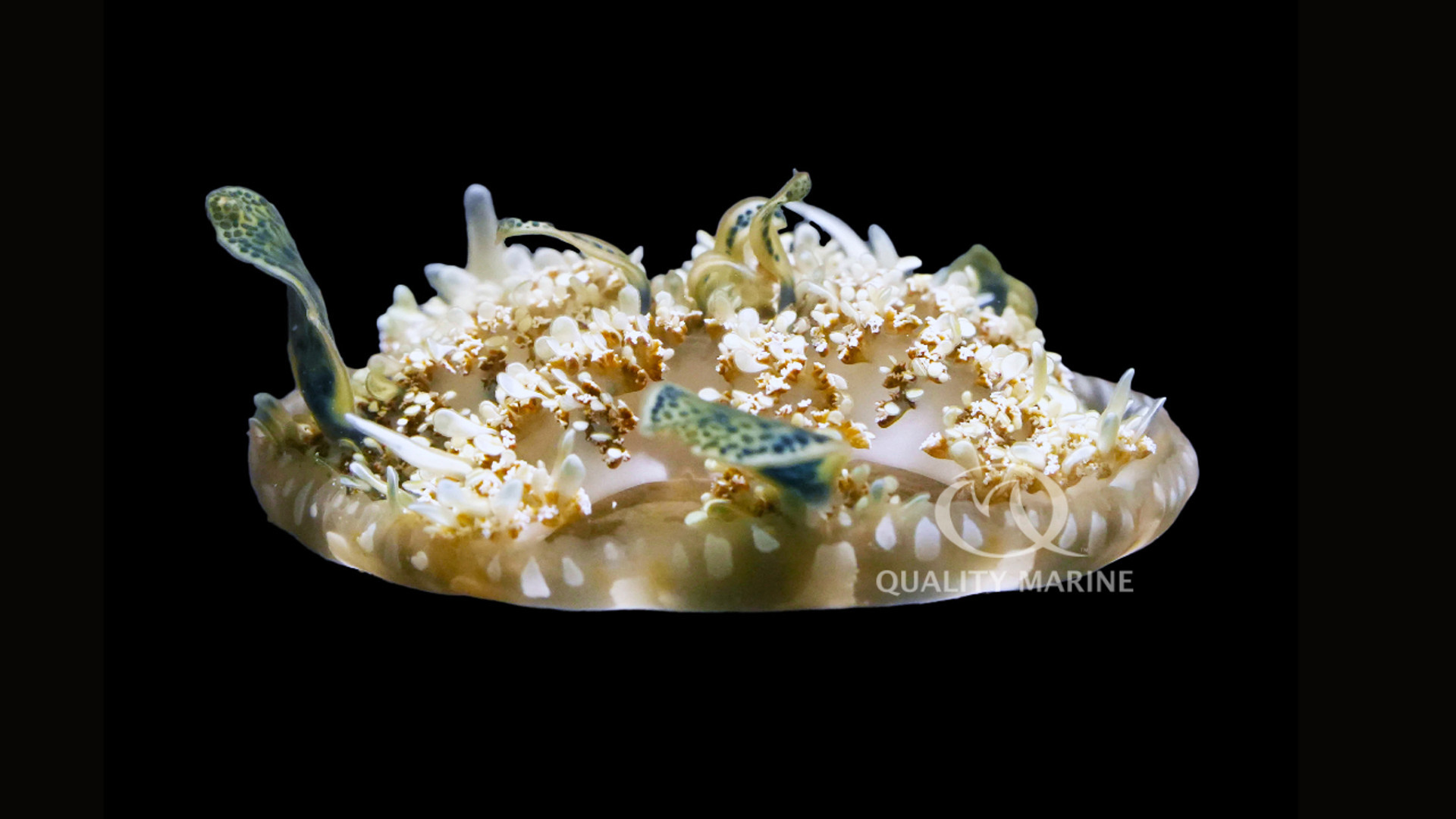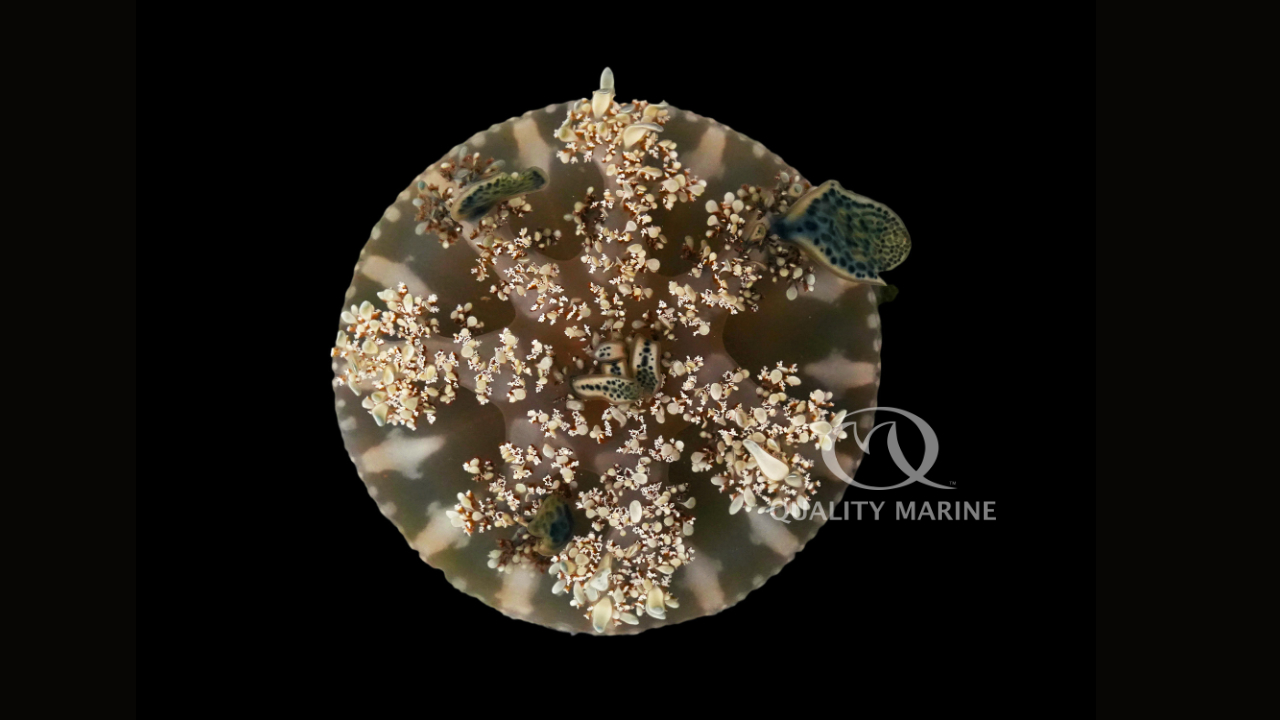Turning Your Display Upside Down

Jellyfish aquariums are a rare sight, and have been for some time; they are unique in how they look and operate and thus aren't for everyone, which is a shame. Most jellyfish require a tank known as a “kreisel.” These are shaped like a cylinder on its side, with a gentle circular flow to help keep the jellyfish suspended. This flow design also aids in getting an appropriate food density in close proximity to the jellyfish. There are several beautiful jellies available to displays in these kinds of tanks, and an article on kreisel tanks is coming.
There is, however, another way to keep jellyfish, and this is by choosing a different type of jelly. Upside-down Jellyfish (Cassiopeia sp) don't require, and shouldn't be kept in, this type of tank. They have evolved to settle out of the water column and live upside down on the substrate of the tank. This means they can / should be kept in standard aquariums! They are gorgeously colored (generally green and blue, though some come through a golden orange color) and patterned with intricate tentacles that extend up into the water column. While these jellies do have a sting, most people have little or no reaction to it. They stay relatively small, rarely getting bigger than 8 inches in diameter across their bell (the top part).
When planning a display for Upside-down Jellyfish, one doesn't need much water volume when compared to other marine aquarium inhabitants. An emphasis should be placed on footprint over depth of display; these critters will need high intensity lighting and water depth just cuts into this. “Breeder” style tanks are great for them, as they fit this bill nicely. Lighting should be as intense as possible, look for lights with high PAR (photosynthetically active radiation) that would otherwise be suitable for keeping clams, hard corals and anemones, more than 200 at the depth of the tank would be a great target. Substrate can be just about anything from sugar sand to crushed aragonite to mangrove leaves (which they love). They will do best with little or no rock work and if rocks or other décor is included, try to maximize the amount of open space on the aquarium bottom for them to attach their suction cup shaped bell to!
While jellies need flow, they are very adversely affected by bubbles, and shouldn't be blown around the tank, so flow needs to be very gentle and extremely well diffused. Luckily the Cassiopeias do best in aquariums with limited filtration, actually requiring some ammonia to reproduce! Many public aquarium displays for Upside-down Jellies will feature under gravel filtration, run in a reverse flow set up, with a surface skimmer to ensure no oil builds up there and any bubbles are removed by the substrate as the water flows gently up through it. Frequently these displays will not feature any type of additional biological filtration and will instead feature a water change schedule that is very regular and consistent. This has the added advantage of ensuring a balanced water chemistry for your display.

In regard to feeding Cassiopeia Jellies, it needs to be done. Much of the input these jellies need is supplied by their zooxanthellae, but not all of it. While they can ingest very small meaty foods, we suggest feeding them zooplankton and substitutes which they will ingest through their multiple mouths! They are not active hunters and so it is possible to maintain a pod culture in the aquarium with them, which is a great idea and can be kick started by adding some Nutramar Tigrio (live copepods) and then feeding those with Nutramar Live Phtyoplankon like the IC or TC product. You can / should also target feed your jellies, by turning off your flow and very gently basting them with a small food like thawed Copepods or Plankton from Gamma Foods or live Artemia nauplii from Nutramar. You'll find feeding your jellies is fun, and if you have a good population of copepods in your tank, you'll only need to feed once or twice a week.
Cassiopeia Jellyfish will do well in aquariums that have pretty standard water quality parameters, shoot for specific gravity somewhere between 1.024 and 1.026, with a pH over 8 and temperatures in the 70s. As we've referenced before, they aren't negatively affected by low (but measurable) ammonia levels, in fact having some measurable ammonia will help their zooxanthellae stay healthy.
Cassiopeia Jellies will reproduce in the home aquarium, and in fact, many public aquariums have been keeping their cultures for years and as such, are now maintaining jellyfish displays that are entirely reproduced in house. The lifespan of these jellies in ideal conditions is roughly a year long, so this reproduction reduces the costs for aquariums to keep them in displays. For the home hobbyist, this will add a challenging element to an otherwise very easy to keep display. Many facilities that keep Cassiopeias report that there are a few stages of this development that function better with higher temperatures (up into the low 80s Fahrenheit) and that some stages are also fueled by a small elevation in ammonia levels. While these jellyfish are very sustainably wild caught, and inexpensive to replace in displays, some of you will undoubtedly want to delve further into breeding them, and another article is coming in the future.
We don't recommend keeping these jellies with other species of jelly, or with anything else to be honest. Keeping a few of them, by themselves in an aquarium is a very pretty display and one worth experimenting with! We've seen people keep them with a few different fish, and with corals elevated on rockwork, but this is a high-risk activity for the Jellies and the other things in the tank. If you're looking for something decorative to house them with, many do well with mangroves in a paludarium type set up, or with any of the several decorative macro algae available (see our article on good and bad alga for the marine aquarium).
There are few displays available to the marine aquarium hobbyist that are remotely this intriguing and different than any other aquarium you can keep. If you're new to jellyfish keeping, the Cassiopeia Jelly has our highest recommendation. Head to your LFS and ask them to get you some from Quality Marine today!